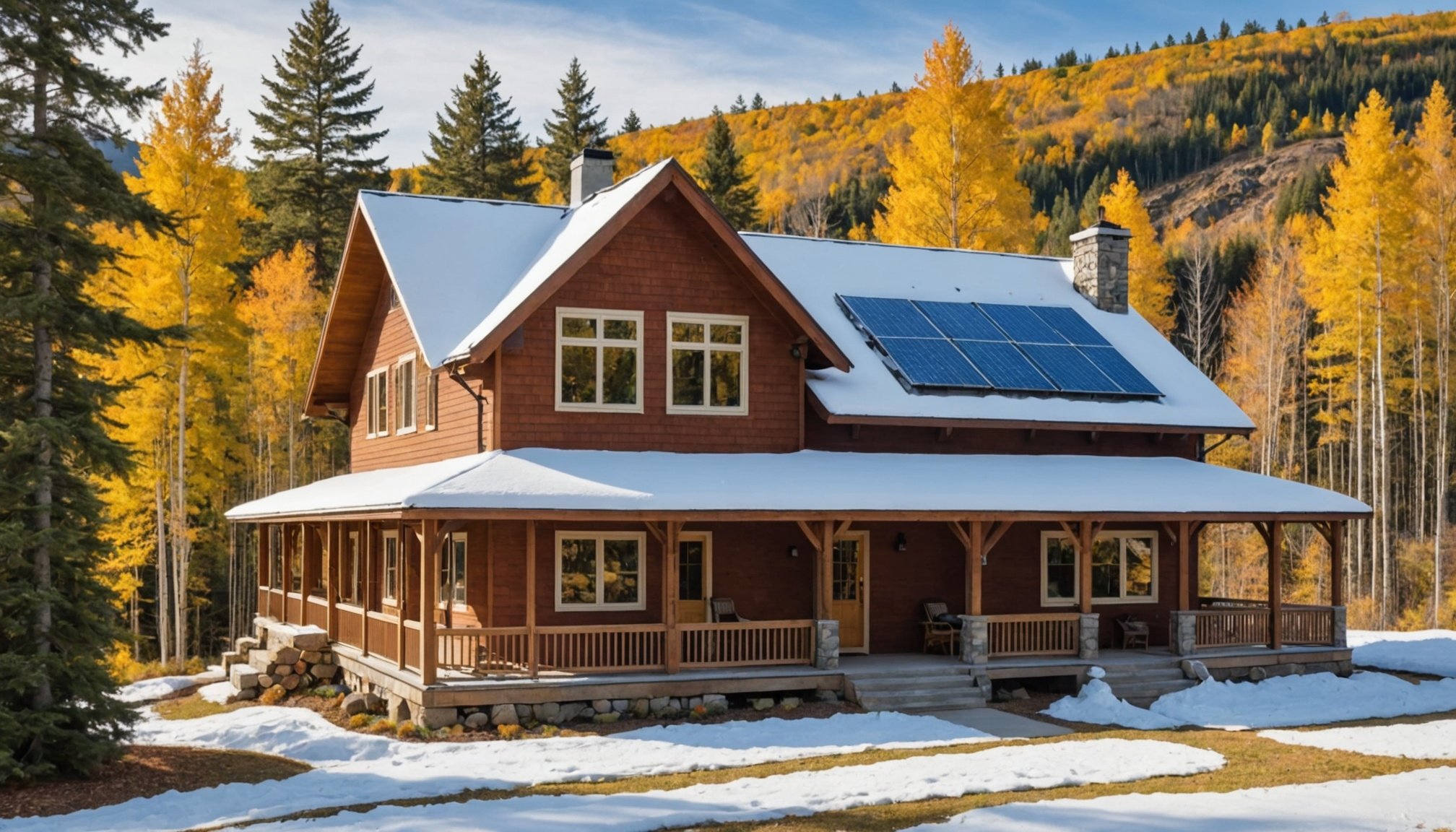Importance of Energy Efficiency in Cold Climates
Living in cold climates presents unique challenges, particularly when it comes to maintaining a warm and comfortable home. Energy efficiency plays a crucial role in addressing these challenges by contributing significantly to both environmental sustainability and economic savings. By focusing on energy-efficient home designs, homeowners can reduce energy consumption, which directly impacts utility bills and carbon emissions.
In cold climates, home heating is one of the highest energy-consuming systems. Therefore, implementing energy-efficient practices can lead to substantial cost reductions in heating expenses. Effective heating systems, such as those that are well-maintained and properly sized for the space, are essential for comfort and savings.
Also read : Discover the Best Eco-Friendly Materials for Your Next Home Renovation Project!
Energy-efficient homes not only benefit individuals economically but also contribute to the broader environmental impact by decreasing greenhouse gas emissions. The demand for heating in these regions makes it even more imperative to optimize energy use.
Moreover, advancements in heating technology, like programmable thermostats, enable greater control over heating schedules, enhancing comfort while saving energy. This proves the importance of integrating energy efficiency into both new and existing homes in cold climates. Ultimately, prioritizing energy efficiency is crucial for sustainable living in these environments, supporting both economic and environmental well-being.
Also to see : Transform Your Kitchen: Clever Hacks for Ultimate Organization and Reducing Food Waste
Insulation Techniques for Maximum Heat Retention
Insulating your home is pivotal for maximising heat retention and achieving optimum energy efficiency, especially in colder climates. Improved insulation not only helps maintain a comfortable indoor temperature but also reduces energy consumption, ultimately lowering utility bills.
Types of Insulation Materials
Selecting the right insulation materials is crucial. Each material has an R-value, which indicates its thermal resistance:
- Fibreglass: Cost-effective and widely used for attics and walls.
- Spray Foam: Offers high R-values and fills gaps effectively.
- Cellulose: Eco-friendly, made from recycled paper, appropriate for tighter spaces.
Insulating Attics and Walls
Strategically insulating attics and walls is essential for minimizing heat loss. Attics, being the highest point in a home, are prime areas for heat escape. Use loose-fill or fibreglass batts. In walls, use materials like spray foam or fibreglass batts to ensure a robust thermal barrier.
Sealing Gaps and Cracks
Effectively sealing gaps and cracks prevents unnecessary heat loss. Common areas include:
- Window frames
- Door edges
- Ventilation ducts
Applying caulk or weather stripping ensures that your insulation efforts are not compromised, maintaining a warm, energy-efficient environment. A well-insulated home stands as a foundation for energy efficiency and reduced heating costs.
Sealing Drafts and Reducing Heat Loss
A critical yet often overlooked aspect of maintaining home comfort in cold climates is effectively sealing drafts to prevent heat loss. Drafts can significantly undermine energy efficiency, leading to increased heating costs and discomfort. Addressing this issue involves identifying the common sources of drafts and the best heat loss prevention techniques.
Identifying Common Draft Sources
Drafts typically originate from areas such as:
- Windows and door frames
- Attics and basements
- Ceiling-to-wall joints
Awareness of these areas enables targeted draft sealing efforts, enhancing overall energy efficiency.
Tools and Techniques for Sealing Drafts
There are several step-by-step methods for sealing drafts, ranging from simple solutions like applying caulk or purchasing draft stoppers to more advanced techniques such as installing door sweeps.
Weather stripping is also a versatile tool that enhances heat loss prevention, creating tight seals at door and window gaps. It is an affordable and effective option for homeowners.
Benefits of Using Weather Stripping
Utilising weather stripping greatly improves energy efficiency. It reduces the workload on heating systems while maintaining a comfortable indoor atmosphere. Alongside its practicality and cost-effectiveness, weather stripping can be easily implemented, offering long-term savings on heating expenditures.
Energy-Efficient Heating Systems
Incorporating energy-efficient heating systems is essential for optimising both comfort and cost savings in homes. These systems rely on advanced technologies and can significantly reduce energy consumption.
Overview of Energy-Efficient Heating Options
There are several energy-efficient heating options available, such as heat pumps, high-efficiency furnaces, and boilers. Each system is designed to maximise thermal output while minimising energy use. Heat pumps, for example, use electricity to transfer heat from the air or ground into the home, offering a renewable energy solution.
Benefits of Programmable Thermostats and Zoning
Programmable thermostats enhance energy efficiency by allowing homeowners to set specific temperatures for different times of the day. Zoning further improves efficiency by heating only the occupied areas of a home, ensuring comfort without waste.
Introduction to Renewable Energy Sources
Integrating renewable energy sources like solar and geothermal into heating systems can yield long-term savings. Solar panels harness sunlight to produce electricity, while geothermal systems use the Earth’s consistent temperature to provide heating efficiently. Both options are environmentally friendly and decrease reliance on fossil fuels, supporting sustainable home heating.
Cost-Saving Measures for Winter Heating
With the harshness of winter weather, implementing cost-saving tips for heating can significantly impact a household’s budget without compromising comfort. Simple, budget-friendly solutions are available to ease the financial burden of increased energy consumption during colder months.
Regular maintenance of heating systems is crucial to ensure their efficiency and longevity. Scheduling annual check-ups with HVAC professionals can prevent small issues from escalating into costly repairs, thus saving money in the long run. Moreover, clogged filters can obstruct airflow, leading to increased energy usage. Replacing or cleaning them regularly optimises system functionality.
Energy assistance programs offer additional avenues for savings. These programmes are often government or utility-sponsored and provide financial assistance or incentives for those who upgrade to energy-efficient appliances. Such initiatives can help reduce upfront costs and lead to long-term savings on utility bills.
Another practical approach is utilising cost-effective methods such as wearing warmer clothing indoors and using draft stoppers to retain heat. Employing these budget-friendly solutions contributes to increased energy efficiency, making winter months more manageable financially. Homeowners are encouraged to explore these strategies to maintain a comfortable and economically viable living environment.
Real-Life Examples and Case Studies
Examining real-life examples and case studies reveals practical insights into home heating solutions and emphasizes the transformative impact of implementing energy efficiency examples. These narratives highlight tangible benefits and lessons learned, underscoring the significance of these strategies.
Successful Home Renovation Projects
Home renovation projects that focus on boosting energy efficiency yield impressive results. A case in Minneapolis demonstrated a 30% reduction in heating costs post-renovation. Key improvements included better insulation and installing energy-efficient windows.
Lessons Learned from Homeowners
Homeowners who have successfully enhanced energy efficiency often share notable insights. Prioritizing insulation and maintaining heating systems is crucial, they found. Additionally, using programmable thermostats significantly optimised energy usage, aligning with varying daily schedules.
Using Infographics and Visual Aids
Infographics and visual aids effectively depict the benefits of energy efficiency. They simplify complex data, illustrating energy savings and the impact on home heating solutions. A popular graphic showcased reductions in carbon footprints after adopting efficient heating systems, making it clear how these changes contribute to environmental sustainability. By choosing visually engaging methods, information becomes more accessible and compelling, encouraging wider adoption of energy-efficient practices.

